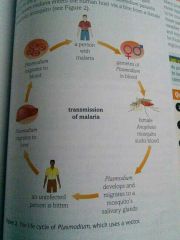![]()
![]()
![]()
Use LEFT and RIGHT arrow keys to navigate between flashcards;
Use UP and DOWN arrow keys to flip the card;
H to show hint;
A reads text to speech;
15 Cards in this Set
- Front
- Back
|
What are the two ways in which pathogens are transmitted? |
1) Direct transmission 2) Indirect transmission |
|
|
Direct transmission |
Direct transmission |
|
|
How are pathogens transmitted through physical contact and how can they be reduced? Give examples of pathogens that are transmitted |
Physical contact is where you touch an infected person or contaminated surface eg. HIV, bacterial meningitis, ring worm, athletes foot. This can be reduced by good hygiene, clean surfaces, barrier contraception |
|
|
How are pathogens transmitted through faecal-oral and how they can be reduced? Give examples of pathogens that are transmitted |
This is transmitted by contaminated food or water eg. cholera, food poisoning. This can be reduced by cooking of food, washing of all fresh food and treating drinking water |
|
|
How are pathogens transmitted through droplet infection and how they can be reduced? Give examples of pathogens that are transmitted |
The pathogen is carried in tiny water droplets in the air eg. tuberculosis, influenza. This can be reduced by catch it - bin it - kill it, cover your mouth when coughing or sneezing and use a tissue ensuring it is disposed of correctly |
|
|
How are pathogens transmitted through transmission by spores and how they can be reduced? Give examples of pathogens that are transmitted |
These can be carried in the air or live on surface eg. anthrax and tetanus. This can be reduced by using a mask and washing skin after contact with soil |
|
|
Name 6 social factors that affect direct transmission |
1) Overcrowding 2) Poor ventilation 3) Poor health 4) Poor diet 5) Homelessness 6) Living or working with people who have migrated from areas where a disease is more common |
|
|
Indirect transmission |
Indirect transmission |
|
|
What is Indirect transmission |
This is where pathogens are transferred using a vector |
|
|
What is a vector? |
A vector is another organism that carries the pathogen to the host |
|
|
How is malaria transmitted? |

|
|
|
How do pathogens enter plants through direct transmission? |
1) Many pathogens are in the soil which can enter the roots directly if the roots have been damaged by replanting, burrowing animals or movement caused by a storm. 2) Pathogens in leaves can be carried back to the soil when plants shed their leaves 3) They can be spread through seeds so new plants are immediately infected |
|
|
How do pathogens enter the plant through Indirect transmission? |
This is usually by a insect attack where spores or pathogens are on the body of the insect that attacks the plant so they act as vectors |
|
|
How does the climate affect the number of diseases there are? |
Many pathogens prefer warm and moist conditions, so as a result warmer climates tend to have a greater variety of diseases. |
|
|
How are viruses less affected by temperature? |
This is because outside the body they are inert chemical packages |

